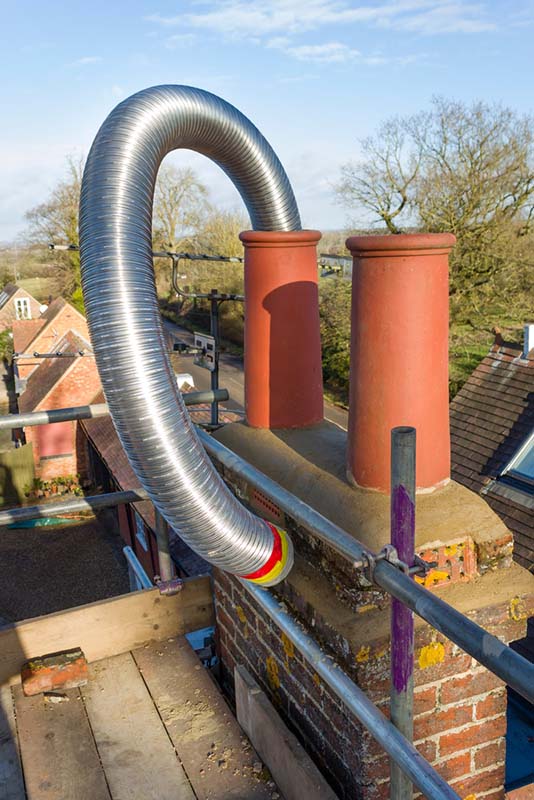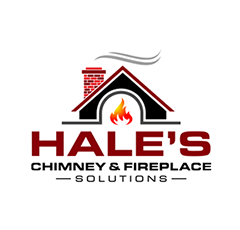We’re Dallas/Forth Worth’s Chimney Relining Professionals
Your chimney couldn’t do its job and make it possible for you to enjoy a fire in your home if it didn’t have a chimney liner. Typically made of metal or clay tiles, the chimney liner provides a smooth, smoke-tight surface for smoke, heat, vapor, carbon monoxide, and other byproducts made by the fire. This surface encourages byproducts to move up and out of the chimney, so they don’t enter your home’s air supply or access framing and other nearby combustibles. But that’s not all the chimney liner does.
The chimney liner also safeguards the masonry of your chimney, keeping it protected against these corrosive byproducts and extreme temperatures, and provides proper draw and draft for an efficient, enjoyable fire. Without it, you’d have smoke pouring into your home or difficulty keeping your fire lit. Long story short…the chimney liner is pretty important. Which leads to the important question – do you ever need to reline your chimney?
Will You Ever Need To Reline Your Chimney? If So, When?
Yes, there are a few different times when you may need to reline your chimney:
Holes and cracks have formed on your existing chimney liner
A hole-riddled, cracked chimney liner is a major threat to the safety and efficiency of your system. Why? These holes and cracks can allow those byproducts (like carbon monoxide) we discussed earlier to enter your home. Heat can also penetrate these areas and ignite a fire in the walls surrounding your chimney. Plus, without a smooth, smoke-tight surface, you can expect efficiency problems, which can detract from the enjoyment and warmth the fire provides.
You’re installing a new appliance that is different from your existing appliance in size or fuel type
Wood, gas, and corn/pellets produce different byproducts, and not every chimney liner material is capable of standing up to each. That’s why, when having a new appliance installed, you’ll need to make sure the chimney liner is approved for venting the new type of appliance. Additionally, the chimney liner needs to be the proper size for efficiently venting the new appliance.
A chimney fire or lightning strike damaged your chimney liner
Chimney fires and lightning strikes can cause extensive damage to the chimney liner and make it ineffective at safely venting the attached appliance.
Your chimney was built without a liner
Wait, what? Yes, you read that correctly – in the past, chimneys were oftentimes made without chimney liners. The National Bureau of Standards (NBS) ruled this as “little less than criminal” after extensive testing revealed the danger of building a chimney without a liner.
We Install Stainless Steel Chimney Liners
If you need to have a new chimney liner installed, Hale’s Chimney & Fireplace Solutions can help. We install stainless steel liners, which are approved for use with all fuel types and carry a lifetime warranty when professionally maintained. Unlike other materials, stainless steel can be used to line your chimney regardless of whether you have a wood-burning, gas-burning, or pellet/corn-burning appliance. And as long as you keep up with annual inspections and professional maintenance, you should never need to replace your stainless steel liner.

Stainless steel chimney liners offer several benefits compared to traditional clay or aluminum liners, including:
- Increased Durability: Stainless steel liners are highly durable and resistant to corrosion, cracking, and damage from chimney fires. This durability ensures a longer lifespan compared to other materials.
- Enhanced Safety: Stainless steel liners provide a smooth, continuous barrier inside the chimney, reducing the risk of chimney fires by containing heat and preventing the buildup of creosote, a highly flammable byproduct of burning wood.
- Improved Draft: A properly sized stainless steel liner can improve draft efficiency by creating a more consistent airflow within the chimney. This can enhance the performance of the fireplace or stove, leading to better combustion and less smoke.
- Fuel Versatility: Stainless steel liners can be used with various fuel types, including wood, gas, oil, and pellet stoves. This versatility makes them suitable for a wide range of heating appliances.
- Ease of Installation: Stainless steel liners are typically easier to install compared to clay liners, as they are lightweight and flexible. This can reduce installation time and labor costs.
- Code Compliance: Stainless steel liners often meet or exceed building codes and standards for chimney installations, ensuring that your chimney system is safe and compliant with regulations.
Is It Time for a Chimney Reline?
If you’d like to schedule a chimney reline or have one of our Chimney Safety Institute of America (CSIA)-certified techs inspect your chimney liner and let you know whether or not you need to consider a reline, give us a call at 972-562-6851 o fill out our online appointment request form. We’re here to help!
A lock-top damper is a great way to control air flow in your chimney while keeping out unwanted water, animals and debris. Ask us for more information about this chimney repair service.
